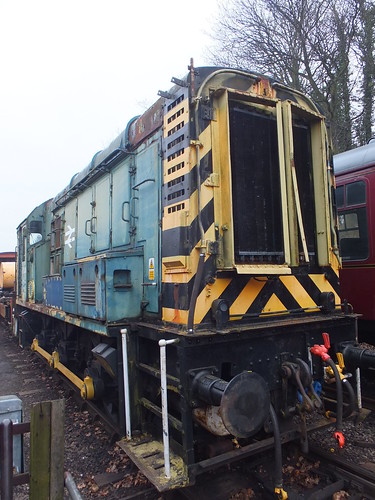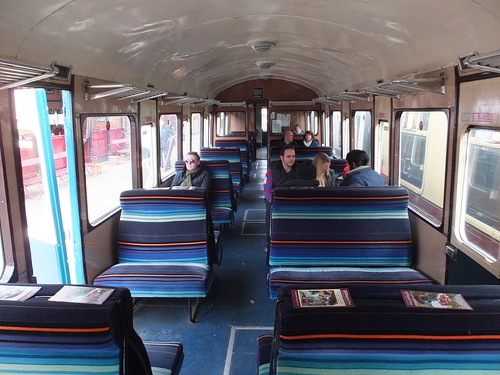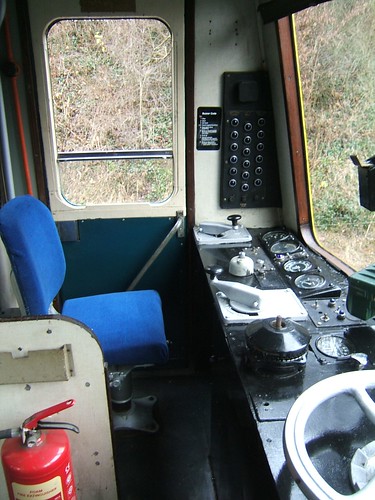Events of Sunday, 3rd March 2013
The Battlefield Line had planned to operate a steam-hauled service on the 2nd and 3rd of March. However, bad weather had delayed the completion of essential track repairs between Market Bosworth and Shenton. The railway substituted a diesel railcar service operating between Shackerstone and Market Bosworth only and I was the driver on the Sunday.
I arrived early and the P.Way gang were assembling the Works Train which would continue the track repairs that day. Diesel electric shunter 08 825 was the Works Train motive power. This locomotive is functional but in need of cosmetic restoration.

Works train locomotive 08 825.
'ED' locomotive 73 114 was also used during the shunt but, on completion, this was stabled on platform 2 along with the coaches forming the normal service train. When the works train departed towards Shention, it comprised a 20-ton brake van, well wagons and a tool van, propelled by 08 825, under the authority of an Engineering Possession for the complete line. Once the Works Train had passed Market Bosworth station, a 'STOP' board and red flag were set to protect the train and the Engineering Possession between Shackerstone and Market Bosworth station was withdrawn by telephone and recorded in the Train Register book at Shackerstone signal box. In the meantime, I'd prepared the single coach 'Bubble Car' 55005 for the passenger service.

'Bubble Car' 55005.
Once the signalman 'cleared' the 'dummy' (ground disk signal - also called 'dolly'), I moved the unit down to platform 1. The sun was starting to peek through but it was still cold, so I started both hot air heater units to warm the coach.
 One of the two underframe-mounted heater units.
One of the two underframe-mounted heater units.
 Passengers on the first service to Market Bosworth.
Passengers on the first service to Market Bosworth.
An 'Emergency' timetable was in use, with departures from Shackerstone at 11:15, 12:30, 13:45 and 15:00. We were 'booked' to stand at Market Bosworth around 15 minutes before returning to Shackerstone. The timetable was carried out without incident. The relative comfort of driving a railcar (rather than steam) makes a nice change occasionally.

The neat arrangement of driving controls in the cab of 55005.
I first became a member at Shackerstone when I was an instructor/driver at Tyseley Railway Museum on their driving experience courses. Tyseley had agreed to run additional courses at Shackerstone using 'Kolhapur' and 'Taw Valley'. Shackerstone's resident engine at the time was 'Lamport No. 3' - a very reliable 6-coupled saddletank which I drove many times until her 'ticket' ran out and she was laid-up in the back of the shed. On 3-Mar-2013, I found 'Lamport No. 3' moved to the DMU siding prior to being moved by road to new owners. I said my farewells and took a few photographs.
 Farewell to 'Lamport No. 3'.
Farewell to 'Lamport No. 3'.
My Pictures
Works Train on the Battlefield Line.
Bubble Car.
Lamport No. 3.
The Battlefield Line Collection.
Monday, 4 March 2013
Sunday Diesel
Saturday Steam
Events of Saturday, 2nd March 2013
The Power Hall, showing the sectioned Beyer Peacock 2-4-0T 'Pender'.
I was rostered as driver with Richard as fireman, Mike as operating officer and Peter as guard at the Museum of Science and Industry (MOSI) in Manchester. 'Agecroft No. 1' was waiting on the pit for us, having recently returned from a short visit to the Ribble Steam Railway. While Richard put a fire in the locomotive, I started oiling-round.
Mike suggested that we assembled the train whilst steam was being raised so we opened the door to the Power Hall (a purely manual operation at present since recent maintenance has resulted in disconnection of the electric motor which used to drive the door).
The Battery Electric shunter was already coupled to the two four-wheel passenger coaches in the Power Hall allowing me to draw the coaches out and place them in the railway compound. Once the gates were secured, we could complete the shunting without crossing areas open to the public. The Battery Electric has recently received a new set of batteries, giving it a new lease of life. Having 'pinned down' the coaches, I moved the shunter to 'Agecroft No. 1', picked it up and put it on top of the coaches and moved the whole train back to the platform. The shunter was then stabled for the day in the railway compound clear of the running line.
The Battery Electric shunter stabled for the day in the railway compound.
The 20-ton brake van had been left on the buffer stop at the end of the platform and Peter elected to run with the brake van attached, allowing him to light the stove in the brake van in order to keep warm.
The Museum is using a new source of Welsh Steam Coal and this performed very well. We were able to do our 'test run' to ensure everything was in order quite early and our first passenger train left around 11:45. Although the day was cold, the sun came out making it quite pleasant and we had plenty of passengers throughout the afternoon. Each time we completed a run, Peter quickly 'ticketed' the next departure (Guards are, once again, manually collecting fares and issuing tickets, since the modern Automatic Ticket Machine at the end of the platform has been taken out of use) so we had little time to relax between trips.
At the end of the day, we detached the brake van and moved the train down the running line to the Disposal Point where we 'knocked the fire out' and emptied the ashpan. Then, I moved the Battery Electric to the head of the train, drew the train forward to clear the Power Hall points and propelled the lot into the Power Hall. An enjoyable, if tiring day!
